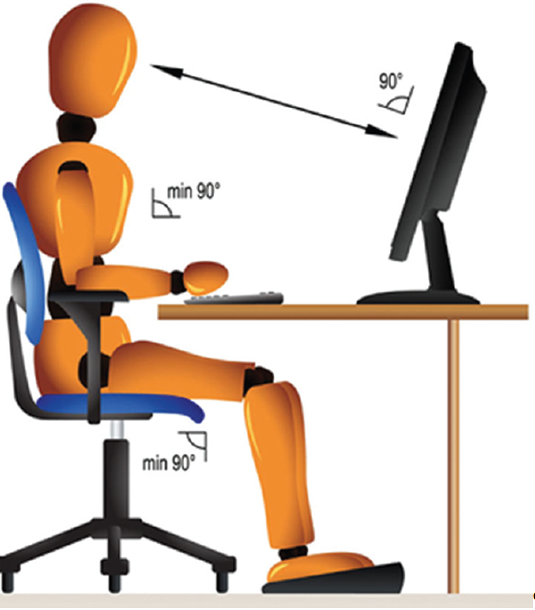Misją Instytutu jest dzialalność naukowo-badawcza prowadząca do nowych rozwiązań technicznych i organizacyjnych użytecznych w kształtowaniu warunków pracy zgodnych z zasadami bezpieczeństwa pracy i ergonomii oraz ustalanie podstaw naukowych do właściwego ukierunkowywania polityki społeczno-ekonomicznej państwa w tym zakresie.
LEGAL CONDITIONS RELATING TO ERGONOMICS AND CONCERNING THE PREVENTION OF MUSCULOSKELETAL DISORDERS
Musculoskeletal disorders, and in particular those concerning the vertebral area, are often classified as lifestyle diseases related to professional activity. In some countries, certain types of MSDs are classified as occupational diseases, in others as para-occupational diseases. In Poland, in accordance with the Labour Code (Act of 26 June 1974 – Labour Code, consolidated text Journal of Laws of 2014, items 1502, 1662, Article 235), an occupational disease is one for which there is a direct relationship between the factor of the work environment causing it and the disease itself. Whereas para-occupational diseases are understood as diseases with complex aetiology, in the development of which working conditions are one of several causal factors, but the share of these factors is not dominant. This means that a para-occupational disease may be linked to working conditions, but non-occupational factors and individual factors linked to a person also presenting a risk of developing that disease.
There are difficulties in defining precisely – especially in a quantitative manner – the mechanisms through which various factors occurring in the workplace affect the musculoskeletal system. However, the efforts to reduce the burden are very important both from an economic and social perspective. Optimal shaping of the work process means ensuring that work not only is carried out under fully safe conditions, but also allows for the comprehensive development of the worker in intellectual, mental and social aspects. This approach is also designed to increase productivity, since optimal working conditions create opportunities and motivation to perform work in a more efficient way. Optimal working conditions occur when the implementation of the principles of ergonomics in the workplace and in the work process is ensured.
The task of ergonomics is to properly shape the work system – both its individual components and in the relations between them. In the concept of ergonomics, the human is an entity and the most important element, and the manufacturing and the product should be shaped for the human as a means of achieving better quality of life.
The term ‘ergonomics’ was introduced for the first time by the Polish researcher, Wojciech Jastrzębowski in 1857. In the magazine ‘Natura i Przemysł’ [Nature and Industry], the article “Rys Ergonomii, czyli nauki o Pracy opartej na prawach zaczerpniętych z Nauki Przyrody” [Sketch on ergonomics, i.e. science on work based on the rights taken from the Science of Nature] he wrote: ‘... the name ergonomics, taken from the Greek words (ergon = work, nomos = natural rights), shall mean Science of Work, i.e. the use of forces and capacities given to humans from the Creator’. Since then, a number of definitions of ‘ergonomics’ have been formulated that capture the different characteristics of ergonomics as science or practice. However, each of these definitions refers to the main objective of ergonomics, which is to achieve a condition in which work and the means to perform it are designed to meet human psychosocial abilities.
Ergonomics relates to both scientific and practical activities. The task of ergonomics in the field of science is to develop a correlation model of the system: human – means of work and the environment, based on the knowledge from all the necessary fields of science, both on humans and technical solutions. The task of ergonomics in practice is to optimise all work elements using good design principles and to continuously improve the area of work organisation and equipment in the workplace.
Solutions adopted in the countries of the European Union through the provisions of the Directives may be considered an important element of introducing principles of ergonomics in workplaces. A Directive of the European Union sets out the result to be achieved, while leaving the national authorities of the Member States free to choose the form and the legal measures to achieve that result. The Directives are divided into the following: Horizontal Directives, Social Directives, Old Approach, New/Global Approach and New Legislative Package.
Social Directives are developed and implemented in the Member States in order to ensure an agreed level of safety and health protection for workers and the working environment in the EU so that working conditions do not adversely affect health. The Directive relating to this issue is the Council Directive of 12 June 1989 on the introduction of measures to encourage improvements in the safety and health of workers at work (89/391/EEC). It obliges the Member States to take broad action to improve the safety and health of workers in their countries. The Directive sets out the concept of health and safety protection and prevention, introduces a new approach in terms of evaluation, reduction and avoidance of occupational risks, and underscores the role of workers and their representatives. In addition to the Framework Directive, a number of specific directives on special aspects of safety and health in the workplace have been adopted. The Framework Directive shall continue to apply to all areas covered by the scope of the specific directives, however where the specific directives contain stricter and more detailed provisions, these provisions shall prevail.
One of the challenges of occupational safety is to reduce the prevalence of musculoskeletal disorders, which has been a continuously demanding task for occupational health doctors and ergonomists for years. Due to the widespread occurrence of cases of musculoskeletal disorders due to professional activities, the directives have been adopted to reduce the extent of these disorders. The most meaningful of them is the fourth individual Directive (within the meaning of Article 16(1) of Directive 89/391/EEC), that is the Directive of 29 May 1990 on the minimum health and safety requirements for the manual handling of loads where there is a risk particularly of back injury (90/269/EEC). The aim of maintaining the health of workers is also achieved by the Council Directive 90/270/EEC of 29 May 1990 on the minimum safety and health requirements for work with display screen equipment (fifth individual directive within the meaning of Article 16(1) of Directive 87/391/EEC). The provisions of this directive are fully applicable as regards the use of display screen equipment by workers. Directive 90/270/EEC and Directive 87/391/EEC are implemented in Poland through the provisions of the relevant regulations.
The Regulation of the Minister of Labour and Social Policy of 14.03.2000 on occupational health and safety during manual transport works and other works related to physical effort consists of 8 chapters: General provisions; General provisions on the organisation of manual transport works; Manual handling of objects by one worker; Team manual handling of objects; Handling of harmful and hazardous materials; Handling of loads by hand-operated trolleys and barrows; Handling of loads by manually operated cranes; and Final provisions.
Chapter 2 (General provisions on the organisation of manual transport works) presents issues concerning the organisation of manual transport works, emphasising that, where possible, manual handling of objects should be avoided, and indicating the conditions under which this is particularly recommended. The conditions are also given for proper space and surface when handling objects manually. A separate section gives instructions on how to handle objects. Attention was also paid to sharp items, packagings and arrangement of lifted items, as well as handling objects on an inclined surface.
Clause 13 ‘Limit on the weight of goods lifted and handled by one worker’ recommends:
- The weight of objects lifted and handled by one worker shall not exceed: a) for women – 12 kg for permanent work and 20 kg for temporary work; b) for men – 30 kg for permanent work and 50 kg for temporary work.
- The weight of objects lifted by one worker above the shoulder girdle shall not exceed: a) for women – 8 kg for permanent work and 14 kg for temporary work; b) for men – 21 kg for permanent work and 35 kg for temporary work.
- If objects are handled by one worker at a distance exceeding 25 metres, the weight of the objects being handled must not exceed: a) for women – 12 kg; b) for men – 30 kg.
- If objects are handled by one worker upwards on an uneven surface, ramps or stairs, the maximum inclination of which is less than 30° and the height exceeds 4 metres, regardless of the distance on which the objects are handled, the weight of these objects shall not exceed: a) for women – 12 kg; b) for men – 30 kg.
- If objects are handled by one worker upwards on an uneven surface, ramps or stairs the maximum inclination of which is more than 30° and the height exceeds 4 metres, regardless of the distance on which the objects are handled, the weight of these objects shall not exceed: a) for women – 8 kg for permanent work and 12 kg for temporary work; b) for men – 20 kg for permanent work and 30 kg for temporary work.
The rules for the organisation of manual transport works, including the working methods used, should in particular ensure:
- limitation of the long-term physical effort, including adequate rest breaks;
- elimination of excessive load on the musculoskeletal system of a worker, in particular vertebral injuries, associated with the work rhythm induced by the work process;
- minimisation of the distance of manual handling of objects;
- taking ergonomics requirements into account.
For works involving manual handling of objects, care shall be taken to provide auxiliary equipment adopted for their size, weight and type to ensure safe and convenient performance of the work.
The regulation also presents the limit values of net energy expenditure during work related to physical effort, including lifting and handling of objects, during a work shift; it cannot exceed 5,000 kJ for women, and 20 kJ/min in the case of temporary work. It was also indicated that the net energy expenditure necessary to perform physical work related to lifting and handling of objects during a work shift shall not exceed 8,400 kJ for men, and 30 kJ/min for temporary work.
The Regulation of the Council of Ministers of 3 April 2017 on the list of burdensome works, hazardous works or works harmful to the health of pregnant and breastfeeding women contains recommendations and permissible conditions for the performance of work by women. For manual transport work, it is recommended to lift within a limited extent:
- The weight of objects lifted and handled by one woman shall not exceed: 12 kg in case of permanent work and 20 kg in case of temporary work.
- If items are handled by one woman at a distance exceeding 25 m, the weight of the items being handled must not exceed 12 kg.
- Team handling of objects exceeding 4 m in length and 20 kg in weight by women shall be permitted provided that one worker lifts or handles a weight not exceeding 10 kg in case of permanent work and 17 kg in case of temporary work.
- Team manual handling by women of objects over a distance exceeding 25 m or exceeding 200 kg is not allowed.
- Temporary work is work performed up to 4 times per hour, if the total duration of such work does not exceed 4 hours per day.
The Regulation of the Minister of Labour and Social Policy of 1 December 1998 on occupational health and safety in workplaces equipped with display monitors presents requirements in the area of spatial structure of the workplace and work organisation. According to the Regulation, the employer is obliged to organise workplaces equipped with display monitors according to the requirements set out in the Annex to the Regulation. The employer is also obliged to evaluate workplaces in terms of work organisation, workplace equipment components, eye strain, mental strain, and to inform workers about the results of this evaluation.
The requirements included in the annex relate to the quality of the image on the display monitor, the desk and the chair, and the equipment of the workplace with the display monitor (Kamińska and Tokarski, 2016).
The display monitor shall meet the following requirements:
- the signs on the screen should be clear and legible,
- the brightness and contrast of signs on the screen should be easy to adjust depending on the lighting conditions of the workplace,
- the image on the screen should be stable, without ripples or other forms of instability,
- the adjustment of the monitor setting shall allow for inclination of the screen of at least 20° backward and 5° forward, and rotation of at least 120° (60° in both directions),
- the display monitor shall be covered with an anti-reflective layer or equipped with an appropriate filter.
It is essential that the positioning of the monitor in relation to light sources reduces glare and reflections. The workstation with the computer should not be situated under the lightning fixtures, and the screen observation line should be parallel to the line of windows.
Workplaces should be equipped with devices suitable for the type of tasks performed on them and for the anthropometric characteristics of workers. The position with the screen monitor should be designed so that the worker has sufficient working space to accommodate all manually operated components within the reach of the worker’s upper limbs. The workplace should be located in such a manner as to provide free access to it. The distances between adjacent monitors shall be at least
0.6 m, and between the worker and the back of the adjacent monitor – at least 0.8 m. The equipment of the workplace and the arrangement of its components must not cause excessive load on the musculoskeletal system.
In order to avoid situations where excessive eye strain occurs, the required distance of the worker’s eyes from the display monitor should be within the range of 400 – 750 mm, and the structure of the table should allow for convenient positioning of the workplace equipment components, including adjustment of the height of the monitor and of the keyboard.
The front edges of the table top should be rounded and the surface of the table top should be matte, preferably of a bright colour. For ergonomic work with the computer, also the dimensions of the table top are important, which should be selected in such a manner as to ensure:
- sufficient space for easy use of workplace equipment and performance of tasks related to the type of work,
- the possibility to set the keyboard at a distance not less than 100 mm from the front edge of the table,
- the possibility of setting the components of equipment at a sufficient distance from the worker, i.e. within the range of the worker’s upper limbs, without the necessity to take forced postures.
The height of the table and the chair seat should be selected in such a manner as to ensure:
- natural posture of the upper limbs when using the keyboard, keeping at least the right angle between the arm and the forearm,
- appropriate viewing angle of the monitor within the range of 20° – 50° downwards (counting from the horizontal line at the height of the worker’s eyes to the line drawn from the worker’s eyes to the centre of the screen), whereas the upper edge of the display monitor should not be located above the eyes of the worker,
- adequate space for placing the legs under the table top.
The chair constituting the equipment of the workplace should have:
- sufficient stability, by providing it with a base, with at least five supports, with wheels,
- dimensions of the backrest and seat ensuring convenient body posture and freedom of movement,
- adjustment of the height of the seat within the range of at least 40 – 50 cm from the ground,
- adjusting the height of the backrest and adjusting the backrest inclination in the range of 5° forward and 30° backward,
- profiling of the seat and backrest suitable for natural bending of the spine and the thigh section of the lower limbs,
- possible 360° rotation around the vertical axis,
- armrests,
- mechanisms for adjusting the height of the seat and the inclination of the backrest shall be easily accessible and simple to operate, and shall be so arranged that the adjustment can be made in the sitting position.

Fig. 1. Recommendations for the workplace with a computer (Kamińska and Tokarski, 2016).
The most important principle for minimising the musculoskeletal load is to adjust the height of the chair and of the table so that the keyboard is at the height of the elbows, with the arms freely lowered (Fig. 4). If the table height cannot be adjusted, a footrest may be needed for shorter workers. The display monitor should be located at a distance of approx. 60 – 70 cm from the eyes (approx. 1.5 of the screen diagonal). The monitor should be positioned directly in front of the worker so that its upper edge is slightly below the eye level, and the angle between the monitor surface and the viewing line on the centre of the monitor should be about 90°. In this way, the proper posture of the neck and the head will be maintained, and the eyes will be less tired (compared to the vertical position of the monitor). The display monitor position should ensure good visual conditions (without reflections and excessive contrast); it should preferably be positioned with the side to the window (Kamińska and Tokarski, 2016).


